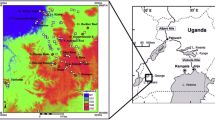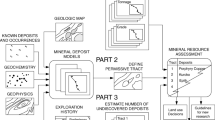Abstract
The spatial distribution of discovered resources may not fully mimic the distribution of all such resources, discovered and undiscovered, because the process of discovery is biased by accessibility factors (e.g., outcrops, roads, and lakes) and by exploration criteria. In data-driven predictive models, the use of training sites (resource occurrences) biased by exploration criteria and accessibility does not necessarily translate to a biased predictive map. However, problems occur when evidence layers correlate with these same exploration factors. These biases then can produce a data-driven model that predicts known occurrences well, but poorly predicts undiscovered resources.
Statistical assessment of correlation between evidence layers and map-based exploration factors is difficult because it is difficult to quantify the “degree of exploration.” However, if such a degree-of-exploration map can be produced, the benefits can be enormous. Not only does it become possible to assess this correlation, but it becomes possible to predict undiscovered, instead of discovered, resources.
Using geothermal systems in Nevada, USA, as an example, a degree-of-exploration model is created, which then is resolved into purely explored and unexplored equivalents, each occurring within coextensive study areas. A weights-of-evidence (WofE) model is built first without regard to the degree of exploration, and then a revised WofE model is calculated for the “explored fraction” only. Differences in the weights between the two models provide a correlation measure between the evidence and the degree of exploration.
The data used to build the geothermal evidence layers are perceived to be independent of degree of exploration. Nevertheless, the evidence layers correlate with exploration because exploration has preferred the same favorable areas identified by the evidence patterns. In this circumstance, however, the weights for the “explored” WofE model minimize this bias. Using these revised weights, posterior probability is extrapolated into unexplored areas to estimate undiscovered deposits.




Similar content being viewed by others
References
Bonham-Carter, G. F., 1994, Geographic Information Systems for geoscientists, modelling with GIS: Pergamon Press, Oxford, 398 p
Bonham-Carter, G. F., Agterberg, F. P., Wright, D. F., 1988, Integration of geological datasets for gold exploration in Nova Scotia: Photogrammetric Engineering and Remote Sensing, v. 54, no. 11, p. 1585–1592
Coolbaugh, M. F., and Bedell, R., 2006, A simplification of weights of evidence using a density function, fuzzy distributions, and geothermal systems, in Harris, J. R., ed., GIS for the Earth Sciences: Geol. Assoc. Canada, Spec. Publ. 44, p. 115–130
Coolbaugh, M. F., Shevenell, L. A., 2004, A method for estimating undiscovered geothermal resources in Nevada and the Great Basin: Proc. Ann. Meeting (Palm Springs, CA), Geothermal Resources Council Trans., v. 28, p. 13–18
Coolbaugh, M. F., Taranik, J. V., Raines, G. L., Shevenell, L. A., Sawatzky, D. L., Minor, T. B., Bedell, R., 2002, A geothermal GIS for Nevada: defining regional controls and favorable exploration terrains for extensional geothermal systems: Geothermal Resources Council Trans. v. 26, p. 485–490
Coolbaugh, M., Zehner, R., Kreemer, C., Blackwell, D., Oppliger, G., Sawatzky, D., Blewitt, G., Pancha, A., Richards, M., Helm-Clark, C., Shevenell, L., Raines, G., Johnson, G., Minor, T., and Boyd, T., 2005, Geothermal potential map of the Great Basin, western United States: Nevada Bur. Mines and Geology Map 151
Coolbaugh, M. F., Faulds, J. E., Kratt, C., Oppliger, G. L., Shevenell, L. A., Calvin, W. M., Ehni, W. J., Zehner, R. E., 2006, Geothermal potential of the Pyramid Lake Paiute Reservation, Nevada, USA: Evidence of at least two previously unrecognized moderate-temperature (150-170°C) geothermal systems: Geothermal Resources Council Trans., v. 30, p. 59–67
Hess, R., 2001, Nevada oil and gas well database map: Nevada Bur. Mines and Geology Open File Rept. 2001–7, unpaginated
Koenig, J. B., and McNitt, J. R., 1983, Controls on the location and intensity of magmatic and nonmagmatic geothermal systems in the Basin and Range province: Geothermal Resources Council Spec. Rept. No. 13, 93 p
Mihalasky, M. J., Bonham-Carter, G. F., 2001, Lithodiversity and its spatial association with metallic mineral sites, Great Basin of Nevada: Natural Resources Research, v. 10, no. 3, p. 209–226
Prudic, D. E., Harrill, J. R., and Burbey, T. J., 1995, Conceptual evaluation of regional groundwater flow in the carbonate-rock province of the Great Basin, Nevada, Utah, and adjacent states: U.S. Geol. Survey Prof. Paper 1409-D, 102 p
Raines, G. L., 1999, Evaluation of weights of evidence to predict epithermal-gold deposits in the Great Basin of the western United States: Natural Resources Research, v. 8, no. 4, p. 257–276
Singer, D. A., 1996, ed., An analysis of Nevada’s metal-bearing mineral resources; Nevada Bur. Mines and Geology Open-File Rept. 96–2, unpaginated
Acknowledgments
This paper has benefited from advice and discussions with Colin Williams and Marshall Reed of the Menlo Park office of the United States Geological Survey. We also want to extend our appreciation to Lisa Shevenell, director of the Great Basin Center for Geothermal Energy, for her encouragement to pursue this investigation. Funding for this research was made possible by a grant from the U.S. Department of Energy under instrument number DE-FG07-02ID14311.
Author information
Authors and Affiliations
Corresponding author
Rights and permissions
About this article
Cite this article
Coolbaugh, M.F., Raines, G.L. & Zehner, R.E. Assessment of Exploration Bias in Data-Driven Predictive Models and the Estimation of Undiscovered Resources. Nat Resour Res 16, 199–207 (2007). https://doi.org/10.1007/s11053-007-9037-6
Received:
Accepted:
Published:
Issue Date:
DOI: https://doi.org/10.1007/s11053-007-9037-6




